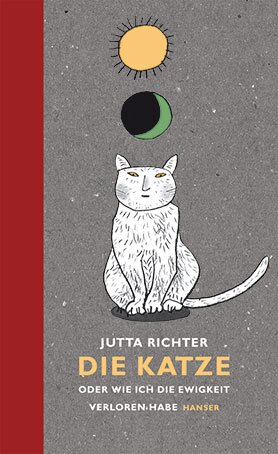Children's Books
Jutta Richter
Die Katze oder Wie ich die Ewigkeit verloren habe
[The cat, or how I lost eternity]
Review
The world in which little Christine lives is not a particularly friendly one. All the grown-ups in it are either subliminally aggressive (like her father), efficient but unloving (like her mother), both stern and ridiculous (like her class teacher and the head teacher at school), or lonely and obviously unhappy (like the postman). So it's not surprising that Christine turns for answers to her questions to an old white cat who meets her every morning on her way to school, delaying her so long that she is regularly late for lessons. As a result her teacher calls her "mischievous" and "Dawdling Dolly".
The cat, who of course can talk, has her very own philosophy of life. She is subversive and rebellious, and thinks poorly of the values represented by grown-ups. When the vicar breaks his leg while chasing a disobedient schoolboy, the cat sees it as a well-deserved punishment for telling the children about original sin and the expulsion from Paradise.
The fate of the Alsatian dog Alf, who is always shut up in his kennel, leaves the cat cold too, for after all, she thinks, he could defend himself. "It's his own fault, she spat. He licks the hand that hits him instead of biting it. He whines for sympathy, caged in his kennel. He bites to order. He lies down when he's told to." When Christine objects that he can't help it the cat does not agree: "Forget it, spat the cat. He's a victim, but he wasn't born a victim. Nobody is. Every animal is free and strong and the world is always wonderful to start with." What is a victim? After thinking about it, Christine draws her own conclusions. "A victim, I thought, a victim, that means pain. Feeling pain of your own free will. A pointless pain, like a prick from an old pin with a green head. A victim is a dog who lets people order him about because he's afraid he won't get fed otherwise."
Fundamentally, what the reader has here is the opposition between the two sides of Christine herself as she tries to work out what is right. She is torn between the two extremes of the loveless, joyless grown-up world, and the fun of provocation as personified by the cat. On the one hand we have the demands made by her parents (and her school) for her to be docile and obedient, on the other the anarchic ideas of the cat, who also takes her on nocturnal dream journeys.
The talking cat stands for a child's experience of a world without temporal and spatial boundaries, and as long as Christine talks to the cat she is part of that world herself. But when she realizes that the cat is not by any means always right, she breaks away from it, and thereby "loses" eternity.
The adult reader almost feels taken back to the repressive atmosphere of the fifties. At the same time, Jutta Richter impressively manages to transport herself into the confusing and confused emotional world of a child who must reconcile her own feelings with the norms and guidelines laid down by adults.
In this little book Jutta Richter's subjects are far from being the simpler questions of life. She tells her story in short, succinct sentences, thus creating the book's own atmosphere, which stimulates or positively requires readers to go on thinking. However, they cannot expect answers any more than Christine can, for we can answer the crucial questions in life only for ourselves.
The artist Rotraud Susanne Berner, winner of many awards, has illustrated the book with clear-cut drawings in black, white and yellow. These illustrations, which are both stylish and slightly austere, divide the story into ten short chapters. It is a beautifully designed book, particularly suitable to be read by grown-ups and children together, for some of the passages might be over-taxing for child readers on their own. Read together, however, this book is sure to stimulate lively conversations.
Translated by Anthea Bell


